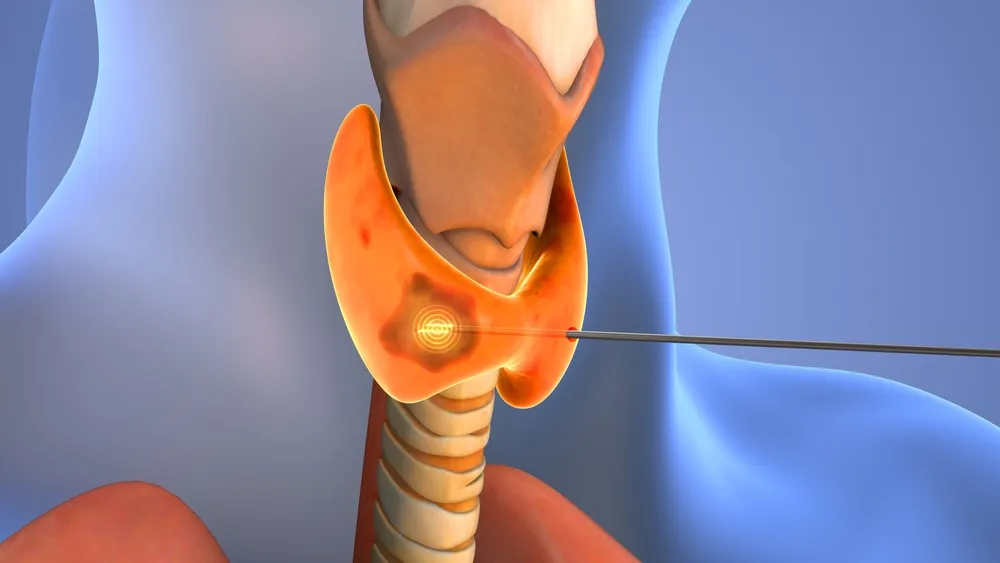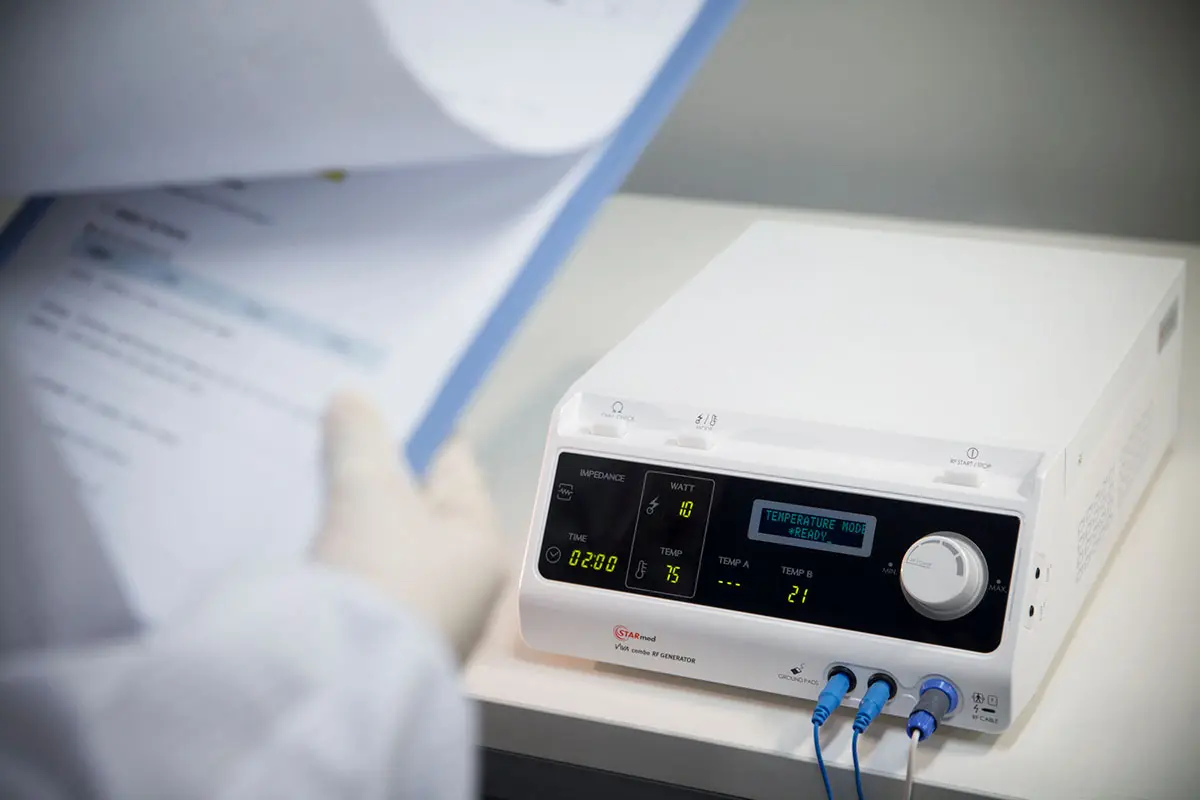Summary: Clinicians evaluating radiofrequency ablation (RFA) vs. microwave ablation (MWA) for benign thyroid nodules must consider long-term efficacy, safety, patient comfort, and practitioner learning curves. While both techniques are minimally invasive and effective, RFA offers modest advantages in volume reduction, safety, ease of learning, and procedure time.
- Volume Reduction: RFA shows better long-term volume reduction (~83% vs. ~77% for MWA at 12 months).
- Safety: Both techniques have low complication rates, though RFA may reduce collateral thermal damage.
- Patient Comfort: RFA procedures are slightly shorter, potentially enhancing patient comfort.
- Cosmetic Satisfaction: Both deliver strong cosmetic results with high patient satisfaction.
- Learning Curve: RFA has a more established training framework, making it easier for new practitioners.
- Clinical Evidence: RFA for Thyroid nodules has been used since 2002, with more than 200 clinical articles proving its efficacy, while microwave ablation for thyroid nodules is a newer technique.
- Hemorrhage
- Voice changes (including hoarseness)
- Skin burns
- Nerve injury
STARmed America provides comprehensive RFA training programs to help clinicians confidently integrate the technique into their practice.
When treating benign thyroid nodules, clinicians often weigh RFA vs MWA as the two leading minimally invasive options. Radiofrequency ablation vs microwave ablation both use thermal energy delivered via a needle probe to destroy thyroid nodule tissue without surgery. Over the following months, the treated nodule shrinks, relieving compressive symptoms and cosmetic concerns. Both treatments are especially appealing when compared to time- and resource-intensive surgical alternatives.
While both techniques are generally safe and effective, recent studies directly comparing microwave ablation vs radiofrequency ablation have highlighted some differences in outcomes and practical considerations.
In this blog, we’ll examine RFA vs microwave ablation across key factors. We will take a close look at recent data on volume reduction, safety, patient comfort, cosmetic results, and the practitioner’s learning curve. We’ll also provide the resources to help you master the RFA technique and begin implementing it in your practice.
Microwave Ablation vs. Radiofrequency Ablation: Long-term Volume Reduction Rates
Both Radiofrequency Ablation and Microwave Ablation are effective at achieving long-term volume reduction in benign thyroid nodules. They both typically reduce nodule volume by more than half within the first 3–6 months. In fact, early follow-up studies (1–3 months) show similar volume reduction ratios (VRR) for microwave ablation vs. radiofrequency ablation.
However, differences emerge over time. By 6 months post-procedure, one meta-analysis found RFA yielding a significantly greater mean volume reduction than MWA. At 12 months, the gap is more pronounced: RFA achieved an average VRR of ~83%, compared to ~77% for MWA.
Similarly, a 2017 multicenter study of over 1,200 patients reported that from 6 months onward, RFA-treated nodules had significantly higher volume and diameter reduction ratios than those treated with MWA.
Importantly, both techniques effectively reduce nodule size for the majority of patients. Over 75% of treated benign nodules achieve at least a 50% volume reduction after either RFA or MWA. Thus, microwave ablation vs RFA offers comparable efficacy in most cases, with RFA holding a modest long-term advantage in mean volume shrinkage.
This enhanced efficacy of RFA may be linked to its more controlled energy delivery, allowing thorough ablation of the nodule’s margins.
RFA vs. Microwave Ablation: Safety and Complications

Safety profiles of radiofrequency and microwave ablation are similar. Both procedures avoid the risks of general anesthesia and hypothyroidism associated with surgery. In comparative studies, overall complication rates for RFA and MWA do not show significant differences.
A recent systematic review including ~2,600 nodules found no statistical difference in the incidence of the following complications:
Serious complications are rare for both techniques. For example, a large multicenter study reported major complication rates of 4.8% with RFA vs 6.6% with MWA. The most common major complication in both groups was transient voice change due to vocal cord nerve irritation. This complication was observed in about 5% of patients.
Some evidence suggests RFA might carry a slightly lower risk of certain side effects. RFA delivers energy in a more targeted, gradual fashion. As a result, it may minimize thermal damage to the neighboring critical structures.
Microwave vs. Radiofrequency Ablation: Patient Comfort and Cosmetic Satisfaction
Both RFA and MWA are typically performed under local anesthesia, sometimes with light sedation. Therefore, patients remain awake, avoiding general anesthesia and its risks.
Studies note that any pain (such as radiating pain to the jaw or ear) is generally transient and quickly alleviated. In larger studies, there are no reports of patients needing to pause either procedure due to pain or discomfort.
However, the length of each procedures may be noteworthy. RFA procedures tend to be somewhat faster than MWA for a given nodule size. Because of the way energy is delivered, RFA often requires moving the electrode in a “peppering” fashion to ablate the entire nodule.
In contrast, MWA may involve a couple of longer static ablations. This small but observable difference in treatment time could reduce the period a patient must remain still, potentially improving their overall comfort.
Furthermore, both RFA and MWA score high on cosmetic outcomes. In clinical trials, radiofrequency ablation vs microwave ablation yielded similar cosmetic improvements. Patients’ cosmetic scores drop significantly after treatment with either method, reflecting that nodules become less noticeable externally.
Patient satisfaction is very high with both techniques, given their minimally invasive nature and outcomes.
Microwave Ablation vs. RFA: Practitioner Learning Curve
Both RFA and MWA require specialized training, and all studies suggest that practitioners improve with experience. This is evidenced by increased volume reduction ratios (VRR) over time. However, one area where RFA may have an edge is in the learning curve for clinicians new to the procedure.
RFA has been performed on thyroid nodules since the early 2000s. Since that time, the procedure has generated a significant track record and established training protocols.
MWA, by contrast, was introduced for thyroid nodules more recently. As a result, clinical experience with thyroid MWA is more limited. Likewise, standardized training guidelines from MWA are not as well defined.
This is also reflected in the recent research. One recent study found that less experienced physicians achieved significantly higher 12-month volume reduction with RFA than with MWA. In the hands of seasoned experts with ten or more years of experience, however, RFA and MWA results were equivalent.
These findings suggest that RFA may be more forgiving for newcomers. In contrast, MWA might require a steeper learning curve for mastery.
This may be partially due to the mechanisms of each procedure. For example, microwave energy rapidly heats a larger volume, which can be harder to titrate in small increments. Thus, MWA raises the risk of overshooting the target area and unintentionally affecting delicate nearby structures. In contrast, RFA’s slower ablation provides more feedback and time to adjust.
With proper training, physicians can become proficient in either technique. However, RFA has an established workflow and ample mentorship opportunities for new practitioners. That makes it a more attractive option for new practitioners starting out with ablative treatments.
Transform Your Clinical Practice with STARmed America
STARmed America offers comprehensive training programs designed to equip physicians with the skills necessary to perform RFA with confidence. Our programs combine theoretical knowledge with practical experience to ensure efficient proficiency in the procedure.
Opportunities include the U.S. Thyroid RFA Training Program, as well as the Master Course of Thyroid Radiofrequency Ablation (MCTR).
For more information on upcoming training sessions and resources, visit the STARmed Academy website.






One Response
Thank you for this informative and well-structured article! The comparison between RFA and MWA ablation treatments was clearly explained and very helpful for understanding the differences in technology, efficiency, and clinical use. I especially appreciated how you broke down the pros and cons of each method—it made complex medical information much more accessible. Looking forward to reading more from your blog!